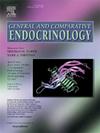Characterization of a crustacean hyperglycemic hormone of the horsehair crab Erimacrus isenbeckii
IF 1.7
3区 医学
Q3 ENDOCRINOLOGY & METABOLISM
引用次数: 0
Abstract
The horsehair crab Erimacrus isenbeckii is widely distributed from Alaska and the Bering Sea through Southern Sakhalin, and in Japan from the coastal areas of Hokkaido to the Sea of Japan. In the Hokkaido area, although strict resource management has been promoted by setting an allowable catch limit, the catch amount has remained at a low level. While knowledge on larval rearing methods is accumulating in relation to seedling production techniques, information on adult growth and molting is limited, due to a deep-sea species that requires a long period for growth. In decapod crustaceans, the sinus-gland/X-organ complex in the eyestalk ganglion synthesizes and secrets various neuropeptides such as crustacean hyperglycemic hormone (CHH) to regulate the homeostasis of haemolymph glucose levels. In this study, combined isolation of sinus gland peptides by reverse-phase high-performance liquid chromatography (RP-HPLC) and amino acid sequencing, and transcriptome analyses using male and female eyestalk ganglion has been successfully identified EiCHHa. In adult male E. isenbeckii, no decrease in haemolymph glucose levels was observed following bilateral eyestalk ablation, indicating that this treatment does not affect glucose homeostasis in this species. Therefore, the in vivo assays of EiCHHa using the blue swimming crab Portunus pelagicus revealed EiCHHa has a hyperglycemic effect, as well as CHHs in other decapod crustaceans. On the other hand, EiCHHa-injected red swamp crayfish Procambarus clarkii with bilateral eyestalk ablation showed no significant increase in hemolymph glucose levels. Additionally, we successfully demonstrated the sexual differences in the transcriptomic profiles between males and females. Especially, two sinus gland-derived neuropeptides (EiCHHb and a crustacean female sex hormone (EiCFSH)) were isolated as female-biased transcripts, suggesting that both hormones may have female-specific roles such as the development of female characteristics and reproduction.
马毛蟹一种甲壳类高血糖激素的研究
马毛蟹Erimacrus isenbeckii广泛分布于阿拉斯加和白令海通过南库页岛,在日本从北海道沿海地区到日本海。在北海道地区,虽然实行了严格的资源管理,设定了允许捕捞限额,但捕捞量一直处于较低水平。虽然有关幼虫饲养方法和幼苗生产技术的知识正在积累,但由于深海物种需要长时间生长,关于成虫生长和蜕皮的信息有限。在十足甲壳类动物中,眼柄神经节中的窦腺/ x器官复合体合成并分泌各种神经肽,如甲壳类高血糖激素(CHH),以调节血淋巴葡萄糖水平的稳态。本研究采用反相高效液相色谱法(RP-HPLC)分离鼻窦腺多肽,并对其进行氨基酸测序和转录组分析,成功鉴定出雄性和雌性眼柄神经节中的EiCHHa。在成年男性大肠isenbeckii,没有观察到血淋巴血糖水平降低双边眼柄消融后,表明这种治疗不影响葡萄糖体内平衡在这个物种。因此,对蓝蟹(Portunus pelagicus)体内EiCHHa的实验表明,EiCHHa与其他十足甲壳类动物的CHHs一样具有高血糖作用。另一方面,注射eichha并切除双侧眼柄的红色沼泽小龙虾克氏原螯虾的血淋巴葡萄糖水平没有显著升高。此外,我们成功地证明了雄性和雌性之间转录组谱的性别差异。特别是,两种窦腺源神经肽(EiCHHb)和一种甲壳类雌性性激素(EiCFSH)被分离为雌性偏倚转录本,表明这两种激素可能具有雌性特异性作用,如雌性特征的发育和生殖。
本文章由计算机程序翻译,如有差异,请以英文原文为准。
求助全文
约1分钟内获得全文
求助全文
来源期刊

General and comparative endocrinology
医学-内分泌学与代谢
CiteScore
5.60
自引率
7.40%
发文量
120
审稿时长
2 months
期刊介绍:
General and Comparative Endocrinology publishes articles concerned with the many complexities of vertebrate and invertebrate endocrine systems at the sub-molecular, molecular, cellular and organismal levels of analysis.
 求助内容:
求助内容: 应助结果提醒方式:
应助结果提醒方式:


